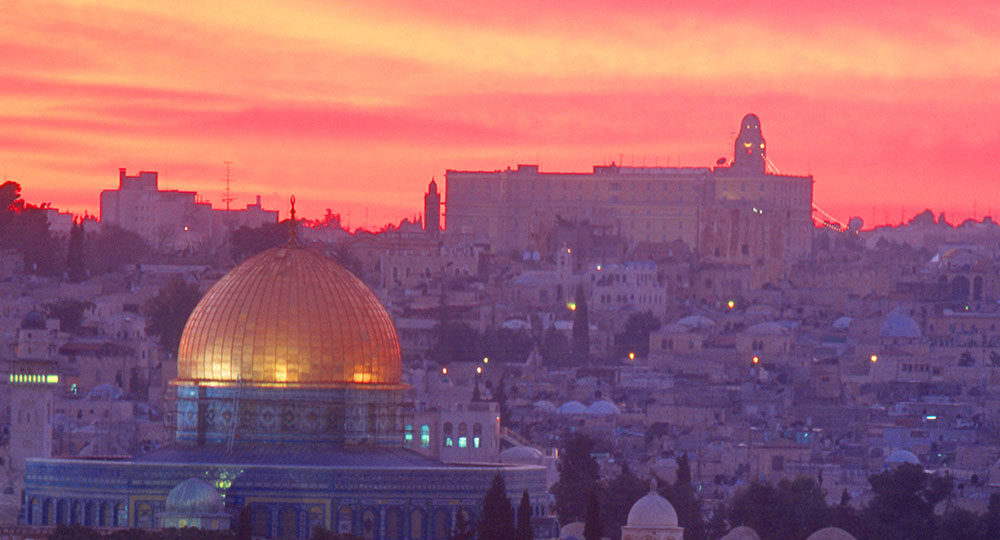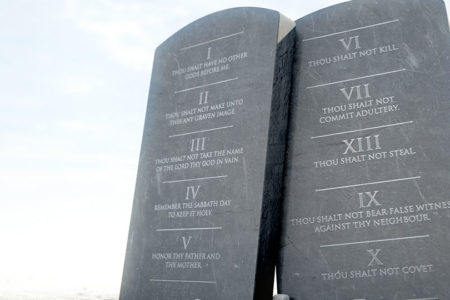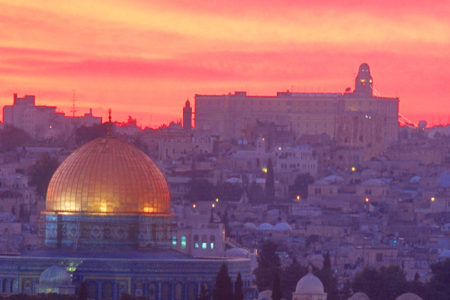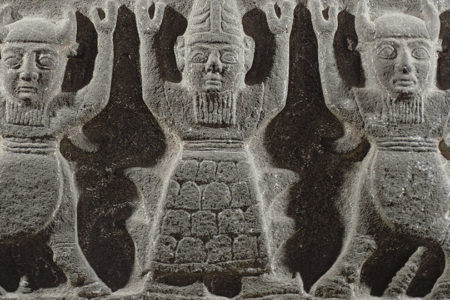Red Skies Over the Temple Mount
When I typed the final chapter of my most recent novel, The Last Judgment, I had no pretensions of prophecy (I still don’t). I wanted to tell a good story in the format of another “legal thriller.” But, as with my other books, both fiction and nonfiction, I also felt pressed to follow Jesus’ admonition in Matthew 16:2–3.
There, when confronted with demands for a “sign,” Jesus pointed out that His listeners followed the age-old adage about the weather, the one that would later translate to the familiar “red sky at morning, sailors take warning; red sky at night, sailor’s delight.”
“You know how to discern the face of the sky,” Jesus said, “but you cannot discern the signs of the times” (v. 3). He made a similar statement that is recorded in Luke 12:54–56.
As I analyzed it, I thought, What better barometer for the spiritual climate of our present age than the status of the Temple Mount? I postulated a religiously motivated attack on the Temple Mount, resulting in a legal and geopolitical conflagration between Israel, Christianity, and Islam.
You can imagine my shock when, just weeks following the release of The Last Judgment, news came from Jerusalem of an alleged plot to take over the Temple Mount. On March 17 Agence France Presse (AFP), an international news agency, noted that on the previous day, Israel’s Channel 2 television aired a video supposedly showing Jewish plotters, including rabbis and, in the AFP’s words, “far-right extremists,” secretly meeting in the Old City to plan a Temple Mount takeover.
Police reinforcements were deployed to the area of the Temple Mount plateau. Immediately Sheik Ibrahim Mudeiris, addressing Muslims at a Gaza mosque, announced that “millions” of Muslims would defend the al-Aqsa Mosque, which is situated on the Mount. Palestinian Authority (PA) Prime Minister Ahmed Qorei joined the chorus, warning that the region would “explode” if Jewish people took any action against the Muslim-controlled site.
The controversy also coincided with efforts by a grassroots Jewish organization to bring some 10,000 Jews to the Temple Mount on the eve of the Hebrew month of Nissan. The group wanted to focus attention on the need for Israeli control of the top of the Mount.
As this cauldron threatened to boil over, an underlying fact grew clearer still: For thousands of years the Temple Mount in Jerusalem has been the most hotly contested piece of ground on Earth. And what happens there reveals much about “the times” in which we live.
According to news reports, the purported takeover was in protest of Israeli Prime Minister Ariel Sharon’s disengagement plan and the unilateral Israeli pullout of Gaza. Whatever the reason, the situation verifies that the final, and most difficult, issue in any peace negotiations will be the Temple Mount. Casting a long view into the future, we can see three ominous and significant trends. Each threatens Israel’s rightful claim to the Mount; but collectively, they also point to future events that ought to leave Bible-believing Christians breathless.
1 Abdicating History
Any approach to the Israeli-Palestinian conflict that obscures Israel’s lawful claim to the Temple Mount is based on a flat-out lie. The Mount was the site of the Jewish Temple of Solomon; the rebuilt Temple as described in Ezra; and finally, the Temple built under Herod. Of course, some leading Muslim clerics try to contest these historical facts. See, for instance, Jimmy deYoung’s article “God’s Holy Mountain,” in the November/December 2004 issue of Israel My Glory, recounting a leading mufti’s astounding claim that no historical evidence exists of a Jewish presence on the Mount.
Volumes of historical and archaeological data could be marshaled to demolish that myth. But the best argument is the concession made by the Muslim Council that controlled the Mount. The Temple Institute and The Jerusalem Post point to a 1930 Muslim-authored tourist booklet about the site entitled A Brief Guide to al-Haram al Sharif, which describes the Temple Mount by saying that its “identity with the site of Solomon’s Temple is beyond dispute.” Any discussion of the Temple Mount that sweeps away Israel’s claims to it suffers from gross historical amnesia.
2 Secularizing Israel
Bernard Avishai, a public policy professor at duke University, typifies the voices now calling for a complete secularization of Israel. In his article in the January 2005 issue of Harper’s Magazine, he even goes so far as to suggest that the Law of Return, which grants automatic Israeli citizenship to Jewish people, must be replaced. In his view, only a secular “democracy” will save Israel and provide a functional future.
But this stance ignores Israel’s 1992 Basic Law and its declaration of Independence, which provide that the values underlining Israeli laws be both “Jewish and democratic.” Avishai and others apparently want to camouflage or radically redefine that first component. In an interview with Legal Affairs magazine, Aharon Barak, president (chief justice) of Israel’s Supreme Court, has opined that the use of the word and in the phrase Jewish and democratic means that legal rules should be made compatible with Judaism if feasible, but should not be dominated by it.
That kind of conciliatory approach could bode ill for any superior claim of Israel to the Temple Mount in the future.
3 Internationalizing the Conflict
Professor Avishai is also typical of many liberals in another respect. In his article he said he wants the international community to govern the “holy sites” in Jerusalem. “Holy sites” meaning “Temple Mount.” Historically, the Palestinians and Arab Muslims have consistently played that tune. In April 2004, when Israeli police clashed with Palestinians at the Temple Mount’s al-Aqsa Mosque, the Organization of Islamic Countries (OIC) called for the European Union (EU) and UN to exercise “international protection” of the Mount.
But now Israeli leaders are joining the band. In a March 22, 2005, op-ed piece in The Wall Street Journal Online, Shimon Peres, Israel’s vice prime minister, suggested that Israel, together with a future Palestinian state and Jordan, be given membership in the EU. Peres noted that “greatness lies” not in a “geographically bound place,” but in “the borderless realm of ideas”; and he pointed to the EU as an example of such a “vision” for the future of Israel.
To some, however, that “vision” might seem more like a nightmare. Imagine the prospect of Israel trying to gain full recognition from, say, France or Germany or the EU hopeful, Turkey. Further, what’s wrong with borders? God is geographically specific in talking about borders when it comes to Israel. (See deuteronomy 34:1–4; Joshua 1:3–4.)
Nor would the United Nations, the other international member of the Middle East negotiating “quartet” (the quartet is the U.S., EU, UN, and Russia), be any better at accommodating Israel’s Old Testament connection to the Temple Mount. The UN’s hostility toward Israel is legendary. A simple review of all of the viperous UN resolutions against Israel proves that point.
Checking the Weather
There are endless scenarios for the Temple Mount. One of them could look like this: The trend toward secularization reinforces an increasing abdication of Israel’s biblical and historical claim to the Mount. Consequently, the chances of Israel successfully promoting an official policy of controlling the top of the Mount become wafer-slim at best. This scenario is consistent with a March 2005 report from Israel National News, which notes that a dahaf Institute survey shows only 51 percent of Israeli Jews favor sole Israeli control of the Temple Mount.
The logical next step would be international control of the site. However, under the 1954 Hague Convention administered by UNESCO (United Nations Educational, Scientific, and Cultural Organization), archaeological digging in “occupied” territories is forbidden. The UN and EU undoubtedly consider all of Israel’s 1967 war acquisitions (including the Old City and Temple Mount) “occupied.” Thus Israel would be barred from any definitive digs that could resolve the intriguing question of where, on the Mount’s plateau, Herod’s Temple actually stood.
Although archaeologists have debated this question for years, it looks like Leen Ritmeyer’s estimate may be closest to the scientific consensus. Ritmeyer, a Temple Mount specialist, postulates that the Temple lies under the Muslim dome of the Rock and Altar of Sacrifice underneath the present-day dome of the Chain.
Will there be a future Jewish Temple on the Temple Mount? Many Orthodox Jews pray for it, wait on it, and plan for it. Bible-believing Christians, such as myself, who read 2 Thessalonians 2:3–4 literally, say yes. There we are told that the “man of sin,” the “son of perdition,” will sit “as God in the temple of God, showing himself that he is God” (emphasis added). This act will mark the imminent return of Jesus Christ.
The linguistic use of the word for “temple” in verse 4 corresponds to the same Old Testament term that denoted the physical Jerusalem Temple.1 Different words could have been used to connote a more symbolic sense, but they were not.
After Jesus walked out of Herod’s Temple and predicted its destruction (Mt. 24:1–2), He sat on the Mount of Olives and elaborated on the end of days. He told His disciples that an “abomination of desolation” would precede the Great Tribulation, which must occur before His glorious appearing (vv. 15, 21). Admittedly, there have been prototypes for this “abomination.” The best-known was Antiochus Epiphanes who, in 167 B.C., plundered the treasury, defiled the Temple, and dedicated it to Zeus. However, Jesus clearly was speaking of an event further in the future, which involved a future Temple and would immediately precede the Great Tribulation and His imminent return.
Where would such a Temple be constructed? Interestingly, there seems to be sufficient room on the 1 million-square-foot plateau itself to house a Temple without disturbing the mosques or the dome of the Rock. And that would be consistent with the internationalists’ “common ground” approach. On the other hand, surprising events may unfold that give Israel the power to control that site itself and thereafter construct a Temple.
Regardless, we must interpret these “signs of the times” by keeping three things in mind: (1) God and His Word are sure, certain, and infallible;(2) His will is supreme; and (3) we have a role to play in this great drama. A prophecy teacher once told me that, although we cannot predict the exact time on God’s great clock, we can surely tell which way the pendulum is swinging. And in so doing, we are to be energetic and committed to the task before us.
Like Paul, we must pray that “God would open to us a door for the Word, to speak the mystery of Christ” and enable us to “walk in wisdom toward those who are outside, redeeming the time” (Col. 4:3, 5).
Now is not a time to be fainthearted or dismayed but to be full of thanksgiving. After all, it’s impossible to watch the skies without looking up.
ENDNOTE
- New International Dictionary of New Testament Theology, Zondervan, s.v. “temple.”








What archaeological evidence exists suggests that the dome of the rock mosque sits where the Courtyard of the Gentiles was on the Temple Mount. So it’s possible a temple could be erected on the mount without disturbing the mosque. The suggestion has also been made by several reputable Bible teachers that the religious center could be returned for the Tribulation period back to where the tabernacle stood for 350 years before King David conquered Jerusalem, at Shiloh.